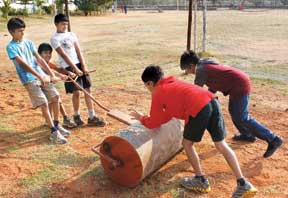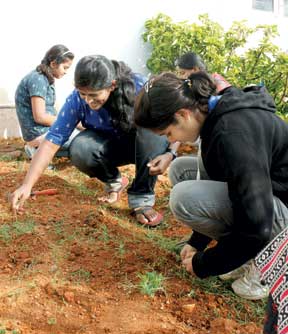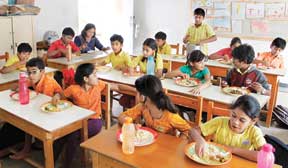Anandhi
The whole of Waldorf education can be viewed from the perspective of health – physical, emotional, and mental. During the first seven years, everything is done to establish health in the child – for health and strength are investments for life! In the second seven years, where the child enters the primary school and then moves into middle school, there is conscious focus on the emotional development of the child. This is also when there is a focus on developing active thinking in the growing adolescent as against “dead thoughts”.
 When the child is about 12 or 13, usually in the seventh grade in a Waldorf school, we work with the idea of health and nutrition. This is brought in at this stage because what is done at this age, in a certain way, bears its fruit as the students enter into adulthood. In an ideal situation, right from the early years, Waldorf schools would encourage parents to bring their awareness to the quality of food that is being offered to children. Many Waldorf schools abroad work closely with ideas of bio-dynamic farming – a manner of farming which treats the earth as a source of life-nourishing energies.
When the child is about 12 or 13, usually in the seventh grade in a Waldorf school, we work with the idea of health and nutrition. This is brought in at this stage because what is done at this age, in a certain way, bears its fruit as the students enter into adulthood. In an ideal situation, right from the early years, Waldorf schools would encourage parents to bring their awareness to the quality of food that is being offered to children. Many Waldorf schools abroad work closely with ideas of bio-dynamic farming – a manner of farming which treats the earth as a source of life-nourishing energies.
At Abhaya, it is still too early to step into these realms, but we certainly talk with parents about the quality of food intake and what is equally important – the quality of the environment while eating. Eating time must be stress-free and relaxed. A very young child has an intuitive connection to its body letting it know how much is good enough. A young child also does not really crave for strongly flavoured, spiced up or sweetened foods. Most often, parents who tend to connect fat with ‘healthy’ resort to the above to push up the quantity of food intake. As a society and culture, perhaps we have begun to lose the wisdom of natural parenting and are plodding our way in a maze of confusing intellectual inputs about food!
The school has a kitchen and our lunch time is a delightfully pleasant time for the whole school. Children from every class scurry to the kitchen to pick up their class’s share of food. Steaming hot food is always welcome and we eat in a peaceful quiet atmosphere in the classes. Occasional shortage is managed when one class shares its excess with another, making sharing the most natural aspect of meal time. The food is delicious and takes care of the basic nutritional needs.
It is only in the higher classes that any cribbing about food is heard – not because they love the food less but because they love ‘cribbing’ more! It is the nature of the adolescent to crib, complain, rebel and…laze! What better time to talk to them about food and nutrition than this!
We teach them about the digestive system, the nerve senses, and the respiratory system. The body is viewed as a receptacle into which various substances and experiences are taken in and the big question of what happens to these substances is explored. The journey of a morsel of rice… it is hard to just start there. Where was all the rice before it reached our platters? With their hands-on experience in class 3 when they would have farmed, and raised a crop, the class usually comes alive with old memories leading to new pictures of what happens when we eat. Although mechanical and chemical processes are involved in digestion, care is taken to avoid building pictures about the body as if it is a machine! The children get a clear picture of what happens to the food as the teacher builds up her lesson. Artistic rendering of the digestive system infuses life into the lessons. No boring diagrams!
We then explore nutrition and talk about health-giving foods and foods that can be harmful. A possibility is created to look at how a farmer can view his land – a space to be exploited commercially or whether he can take responsibility for its life-forces? It could later on be linked with economics – after all who is the real beneficiary of the rape of the earth? Adults connected with organic farming and foods can contribute various ideas to the growing youngster.
For an adolescent who thrives on junk, even just giving facts can sometimes be an eye-opener. This is also a time when we explore food cravings. We are careful not to become moralistic, for an adolescent’s sense of judgment needs to awaken through reason and logic. Does it mean our children are an enlightened lot who do not touch junk? We shall come to this later in relation to addictions.
 Discussions on the nerve senses include the senses and how we take in experiences through our senses and process them inwardly (a form of digestion of experiences). What happens when a very young child is exposed to bright lights or loud sounds? While, as a culture, we understand that the tender digestive organs cannot digest a meal meant for an adult, we often miss the corollary with sense experiences. We do not think much about exposing young children to loud noises, loud colour, or emotionally ‘loud’ experiences. At 12 or 13, the young student is able to relate to these ideas and he/she begins to perhaps understand why as a school we keep our kindergarteners in a peaceful, serene, sense-nourishing atmosphere. The nerve-sense area allows for discussions on alcoholism, smoking, and drugs. We invite adults to the class to share their personal experiences with regard to these ‘temptations’ that are more easily accessible to youngsters these days. Again, to keep lessons from the pitfall of stated ‘moral values’ needs great tact. Do Waldorf school students keep away from temptations? Of course not! The sign of a healthy adolescent perhaps is his or her eagerness to try and taste the forbidden fruit. There has been some research done in this area abroad that has pointed to the fact that while students from Waldorf schools are as attracted to all of these, the number of students actually turning into addicts is far less. This perhaps has to do with, among other things, responsible parenting and the fact that the methodology of teaching in a Waldorf school allows for independent judgment to awaken when they step into adulthood.
Discussions on the nerve senses include the senses and how we take in experiences through our senses and process them inwardly (a form of digestion of experiences). What happens when a very young child is exposed to bright lights or loud sounds? While, as a culture, we understand that the tender digestive organs cannot digest a meal meant for an adult, we often miss the corollary with sense experiences. We do not think much about exposing young children to loud noises, loud colour, or emotionally ‘loud’ experiences. At 12 or 13, the young student is able to relate to these ideas and he/she begins to perhaps understand why as a school we keep our kindergarteners in a peaceful, serene, sense-nourishing atmosphere. The nerve-sense area allows for discussions on alcoholism, smoking, and drugs. We invite adults to the class to share their personal experiences with regard to these ‘temptations’ that are more easily accessible to youngsters these days. Again, to keep lessons from the pitfall of stated ‘moral values’ needs great tact. Do Waldorf school students keep away from temptations? Of course not! The sign of a healthy adolescent perhaps is his or her eagerness to try and taste the forbidden fruit. There has been some research done in this area abroad that has pointed to the fact that while students from Waldorf schools are as attracted to all of these, the number of students actually turning into addicts is far less. This perhaps has to do with, among other things, responsible parenting and the fact that the methodology of teaching in a Waldorf school allows for independent judgment to awaken when they step into adulthood.
We then look at the respiratory system and its marvelous complementary connection to the plant world. Again, we could leave them with a sense of responsibility of keeping the environment clean. The students at Abhaya experience, on a day-to-day basis, the difference between the polluted air of the city and the clean air at school. The school is located amidst the green fields of Kompally, in Hyderabad. Blake’s ‘Echoing Green’ is an everyday experience for our children. There was once great excitement after the students found ‘Lichens’ at school. It is one thing to read that Lichens need an unpolluted atmosphere and another to see them grow at school. The big question is who sustains this. Is each of us going to feel responsible or do we leave the ‘care taking’ to others – nameless, faceless entities?
 One particular class ended their block period on health and nutrition with a hilarious play. It addressed questions like anorexia, bulimia, and obesity. The students had scripted it with some help from the teacher. Humour is perhaps the best and most digestible opposite of moralizing – a pleasant memory lingering in the collective class-consciousness.
One particular class ended their block period on health and nutrition with a hilarious play. It addressed questions like anorexia, bulimia, and obesity. The students had scripted it with some help from the teacher. Humour is perhaps the best and most digestible opposite of moralizing – a pleasant memory lingering in the collective class-consciousness.
The school has begun a very simple program on caring for our environment – just the beginning of separating paper from plastics and reducing the plastics has been an uphill task since it asks for consistency! We actively work in our garden with all the classes and have started composting.
Health with regard to emotions, the quality of relationships – whether abusive, exploitative or supportive – and nurturing, is another area that is touched upon.
Central to the question of ‘health and nutrition’ lies the question of our view of the human being. Is the human being a living machine? Is he a helpless victim (successful or unsuccessful as the case may be) of social, economic, and cultural forces that make him an object. Or is he a free human being who can truly take responsibility for his health and wellbeing and be contributive towards others? This calls for “health-in-thinking”. On the one hand, the intellect binds itself to what could be the dogma of the mind. After all, there is a difference between the spirit of science which is about questioning with a real sense for truth, and ‘scientific dogma’. On the other hand, religion wants us to wrap up clear thinking at the altar of faith. What is health-in-thinking amidst these polar forces? Do we care about our children enough to make them free individuals who can direct their lives amidst the sea of chaos they are placed in?
The author teaches at Abhaya – a Waldorf school, Hyderabad. She can be reached at anandhi.abhi@yahoo.com.
Students, now in class 9, share some thoughts and feelings that stayed with them after the lesson on health and nutrition taught in class 7.
‘Fat ’. The word fat brings the image of an obese person to my mind! You say ‘junk food’? You may not be entirely wrong. This in turn may also carry a negative meaning in one’s mind.
In the context of ‘nutrition’, fat is one of the most important words. People say that you must have a healthy diet. Often, people say you must have a sufficient intake of all the nutrients, avoid ‘fat’ as it is bad. This is not true at all. The intake of fat is just as necessary as the intake of other nutrients. During the times when the body does not have energy, it uses the fat stored previously to help it function. Did you know that fats in our body help in holding the organs together?
These are a few important facts that I learned in the block. It gave me a whole new perspective to a lot of things that I used to take for granted.
– Shreya
I love playing sports. In order to do what I love, I am required to be fit. Till we started the block on nutrition, I had no idea how much junk I was eating. I thought since I played a lot, I could eat whatever I want and burn it. Once I changed my eating habits, I noticed my ability to run faster. I used to run a 100 mts in about 20 seconds earlier. After dropping junk from my diet, I noticed that I was able to do it in about 13 seconds.
Of course, people should not starve themselves to be thin. If you are 15 and above, and have not been eating health-giving foods and exercising regularly, it’s high time you did!
– Ananya
In class seven, after reading an article about the damage that the Coca Cola company had done in Plachimada, Kerala, a few of us from the class decided that we would stop drinking Coke in protest. We knew it wouldn’t affect the company in any way, whether five school students in another city drank their products or not, but it seemed like the right thing to do. After we spoke to our classmates about it, our whole class decided to stop drinking soft drinks. Although that endeavour didn’t last too long – many students caved in deciding there was no point to it – ten years later there are still some of us who have stuck with the decision. For me, it doesn’t just end with soft drinks. I try and reduce the consumption of most packaged foods. This I do for a number of reasons – mainly the negative effects they have on both our health and the environment alike. It was much later, that I realized that our initial decision to stop drinking Coke came about during the ‘Health and Nutrition’ block in school. Maybe it was all the lemon tea (made from fresh lemon grass in school) that we drank in class, during that block and the months afterward, that somewhere made an impact on our way of thinking. Maybe it was our ‘Farming’ block and our weekly gardening sessions that made us connect to the natural world in a way that most students from conventional schools do not understand. I don’t think it’s possible to pinpoint precisely what influenced us, but now looking back, I can safely say that school had a lot to do with it!
– Abhinaya (ex-student)
